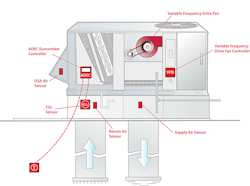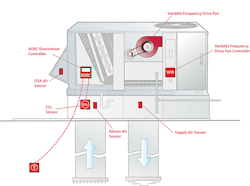National Comfort Institute (NCI) receives an increasing volume of tech support calls about Variable Frequency Drives (VFD) almost every month. Let's take a look at the top five VFD tech support questions and their answers.
Technicians initiate many tech-support calls after discovering VFDs that were never set up or adjusted since the equipment left the factory. Uncommissioned VFDs can hurt system performance, mess up a building, and skyrocket energy costs when not correctly set up.
What is a VFD?
The most common HVAC definition of a Variable Frequency Drive describes it as an electrical device used as a fan accessory to increase and decrease the rotations per minute (RPM) of an alternating current (AC) motor. The VFD adjusts the electrical power frequency supplied to the motor to vary system airflow. VFDs are also used on pumps and compressors, but we'll stick to the airside today.
The primary function of a VFD is to adjust and change fan speed to predetermined set points. The system reacts to the change in airflow in a predictable manner to achieve improved ventilation. VFDs also respond to open and closed zone controls and vary system airflow to satisfy different heating or cooling stage requirements.
Not long ago, VFDs were considered a new HVAC technology and had a high price tag. Today, the price continues to fall, and contractors, equipment, and control manufacturers are finding new technologies to integrate into HVAC systems.
What are the benefits of using a VFD?
The increasing advancement of electronic and control technology significantly improves VFD performance. Such improvements deliver increasing benefits and flexibility. For example
- Improved ventilation – You may have read many of my articles this last year about the changing ventilation scene. VFD's are an essential component in controlling airflow to create safe and healthy buildings.
- Indoor air quality is improved as controls respond to better control temperature, humidity, pressure, and carbon dioxide (CO2) levels in buildings.
- Saving energy is a big plus as fan motor watt consumption decreases anytime the motor operates at less that maximum capacity. Reduced motor speed provides a significant reduction in motor power usage.
- Reduced maintenance. One unseen and rarely recognized benefit of a VFD is the lower wear and tear and increased life it provides the fan motor. VFDs reduce startup shock and ensure smooth changes in fan speed.
How do I adjust airflow with a VFD?
You adjust VFDs to setpoints selected to deliver the required fan airflow needed to perform a particular task. Here are six simplified steps you'll take to adjust airflow using a VFD to control the fan:
1. Measure and record the initial airflow delivered by the fan as it currently operates.
2. Read and record the current VFD operating hertz (Hz). The Hz setting is usually displayed on a small screen on the VFD. You'll use the Hz readout to calculate the new VFD setting, not the fan RPM.
3. Determine system airflow requirements for the fan to deliver.
4. Apply an inversed version of Fan Law One to calculate the new Hz setting for the VFD to deliver the required airflow. See the next section for the math. It's not that hard, I promise.
5. Adjust the VFD hertz setting to match your calculation, and the airflow will increase or decrease to the desired rate.
6. Verify airflow using a traverse or another balancing method. Also, check fan amps and static pressure to make sure the system is within design parameters.
How do I calculate the new VFD hertz setting?
First, use the field data you gathered from the first, second, and third steps above. Then, plug the numbers into this version of Fan Law One:
Here's what you'll do in the field: Let's say you measure and verify that a 15-ton fan delivers 5850 cfm with the system controls calling for stage three cooling. You read the VFD at 50 Hz.
Should you decide to accept it, your mission is to adjust the fan to deliver the 4000 cfm required for phase two cooling.
Now convert your field data to Fan Law One language. CFM2 is the 4000 CFM you'll need for stage two; CFM1 is the 5850 cfm the fan is currently delivering at stage three. Hertz1 is the 50 Hz setting on the VFD in stage three cooling. Now, work on the math. You divide once and multiply once to find your new VFD setting for stage two cooling.
Solve the equation as follows: 4000 ÷ 5850 = .68 or 68%. This means stage two cooling airflow is 68% of stage three cooling airflow.
Multiply .68 x 50 Hz to discover the 34 Hz will deliver 4000 cfm. So now, if you set the VFD to 34 Hz, your airflow will drop to 4000 cfm.
You adjust the VFD to 34 Hz, measure fan airflow, and find it to be 4038 cfm. You're done. Good job.
How do I calculate airflow for each stage of cooling?
There are many reasons to adjust airflow with a VFD, but this is the most common tech support scenario we receive.
In a perfect world, the designer or manufacturer specifies airflow for each stage of cooling. Or even better, the compressor has a VFD of its own. But it's not time to go there … yet.
When you need to determine cfm for each heating or cooling stage, here's what you may choose to do.
1. Inspect the equipment and determine the number of stages of cooling it has. This may be as easy as counting how many compressors it has.
2. Read the compressor tag and find its rated Btu capacity. If there are multiple compressors, do this for each one. Divide the compressor rating by 11,500 (This is a rough Btu-per-ton to estimate compressor tonnage). Round off to the nearest common tonnage.
3. Multiply the compressor tonnage for each stage of cooling by 400 cfm per ton. For example, if a 20-ton unit has four 5-ton compressors and stage three uses three compressors: three compressors x five tons each = 15 tons. Fifteen tons x 400 cfm per ton = 6000 cfm.
If you're at a high-altitude location, you will need to increase the cfm per ton to adjust for air density. If you are in a humid area, adjust airflow down to increase dehumidification, perhaps to 325 cfm per ton.
That's the tip of the VFD iceberg. As many of you know, there is much more to learn and skills to develop in our industry. I hope this short article better equips you to embrace your increasing encounters with VFD fans in the future.
Rob "Doc" Falke serves the industry as president of National Comfort Institute, Inc., an HVAC-based training company and membership organization. If you're an HVAC professional interested in a free procedure about how to use fan laws, contact Doc at ncilink.com/ContactMe or call him at 800-633-7058. Go to NCI's website at nationalcomfortinstitute.com for free information, articles, downloads, and current training opportunities
About the Author
Rob 'Doc' Falke
President
Rob “Doc” Falke serves the industry as president of National Comfort Institute an HVAC-based training company and membership organization. If you're an HVAC contractor or technician interested in a building pressure measurement procedure, contact Doc at [email protected] or call him at 800-633-7058. Go to NCI’s website at NationalComfortInstitute.com for free information, articles and downloads.




